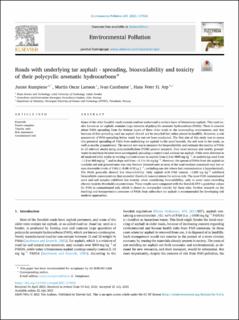| dc.contributor.author | Kumpiene, Jurate | |
| dc.contributor.author | Larsson, Martin Oscar | |
| dc.contributor.author | Carabante, Ivan | |
| dc.contributor.author | Arp, Hans Peter | |
| dc.date.accessioned | 2022-02-14T09:10:43Z | |
| dc.date.available | 2022-02-14T09:10:43Z | |
| dc.date.created | 2021-08-13T11:59:12Z | |
| dc.date.issued | 2021 | |
| dc.identifier.citation | Environmental Pollution (1987). 2021, 289 1-8. | en_US |
| dc.identifier.issn | 0269-7491 | |
| dc.identifier.uri | https://hdl.handle.net/11250/2978638 | |
| dc.description.abstract | Some of the older Swedish roads contain road tar underneath a surface layer of bituminous asphalt. This road tar, also known as tar asphalt, contains large amounts of polycyclic aromatic hydrocarbons (PAHs). There is concern about PAHs spreading from the bottom layers of these older roads to the surrounding environment, and that because of this spreading road tar asphalt should not be recycled but rather placed in landfills. However, a risk assessment of PAH spreading below roads has not yet been conducted. The first aim of this study was to assess this potential spreading of PAHs from underlying tar asphalt to the sand beneath, the soil next to the roads, as well as nearby groundwater. The second aim was to measure the bioavailability and estimate the toxicity of PAHs in all relevant media using polyoxymethylene (POM) passive samplers. Four road sections and nearby groundwater in northern Sweden were investigated, including a control road without tar asphalt. PAHs were detected in all analysed solid media at varying concentrations: in asphalt from 2.3 to 4800 mg kg−1, in underlying sand from <1.5 to 460 mg kg−1 and in slope soil from <1.5 to 36 mg kg−1. However, the spread of PAHs from the asphalt to roadside soil and groundwater was very limited. Groundwater at most of the road sections contained very low or non-detectable levels of PAHs (<0.08–0.53 μg L−1, excluding one site where fuel contamination is hypothesized). The PAHs generally showed low bioavailability. Only asphalt with PAH content >1200 mg kg−1 exhibited bioavailable concentrations that exceeded threshold concentrations for serious risk. The most PAH contaminated sand and soil samples exhibited low toxicity when considering bioavailability, only in some cases exceeding chronic toxicity threshold concentrations. These results were compared with the Swedish EPA's guideline values for PAH in contaminated soil, which is shown to overpredict toxicity for these sites. Further research on the leaching and transportation processes of PAHs from subsurface tar asphalt is recommended for developing risk analysis approaches. | en_US |
| dc.language.iso | eng | en_US |
| dc.publisher | Elsevier | en_US |
| dc.rights | Navngivelse 4.0 Internasjonal | * |
| dc.rights.uri | http://creativecommons.org/licenses/by/4.0/deed.no | * |
| dc.title | Roads with underlying tar asphalt - spreading, bioavailability and toxicity of their polycyclic aromatic hydrocarbons | en_US |
| dc.type | Peer reviewed | en_US |
| dc.type | Journal article | en_US |
| dc.description.version | publishedVersion | en_US |
| dc.source.pagenumber | 1-8 | en_US |
| dc.source.volume | 289 | en_US |
| dc.source.journal | Environmental Pollution (1987) | en_US |
| dc.identifier.doi | 10.1016/j.envpol.2021.117828 | |
| dc.identifier.cristin | 1925778 | |
| cristin.ispublished | true | |
| cristin.fulltext | original | |
| cristin.qualitycode | 1 | |

